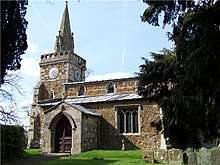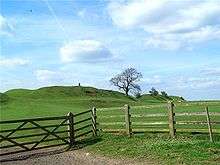Burrough on the Hill
Burrough on the Hill is a small village 12 miles (19 km) north east of Leicester in England.[1] The parish church is St. Mary Close. Burrough Hill is an Iron Age hill fort near the village and is in an 86-acre (35 ha) country park of the same name.[2] The hillfort stands on a promontory around 660 feet (200 m) above sea level, 7 miles (11 km) south of the modern settlement of Melton Mowbray.[3] The population of the village is included in the civil parish of Somerby, Leicestershire


The village shared John O' Gaunt railway station with the neighbouring village of Twyford. The station was adjacent to a 14-arch viaduct. Trains used to go north to Melton Mowbray, and south to Leicester and Market Harborough, but the line was closed in the 1960s. There is a local bus service to Melton Mowbray and Oakham.
Population
| Population growth in Burrough on the Hill since 1801 | |||||||||||||||
|---|---|---|---|---|---|---|---|---|---|---|---|---|---|---|---|
| Year | 1801 | 1811 | 1821 | 1831 | 1841 | 1851 | 1881 | 1891 | 1901 | 1911 | 1921 | 1931 | |||
| Population | 138 | 138 | 183 | 173 | 149 | 135 | 149 | 139 | 149 | 200 | 206 | 214 | |||
| Source: A Vision of Britain through Time and the Office for National Statistics[4] | |||||||||||||||
Famous Horses
British thoroughbred racehorse Burrough Hill Lad was named after Burrough on the Hill by owner Stan Riley, who was born and raised in the village. After a run of victories in 1984 including the Cheltenham Gold Cup, Hennessy Gold Cup and King George VI Chase, Burrough Hill Lad was considered one of the greatest racehorses in the history of the sport.[5]
References
- J.M. Lee; R.A. McKinley, eds. (1964). "Burrough on the Hill". A History of the County of Leicestershire: Volume 5: Gartree Hundred. pp. 61–68. Retrieved 7 May 2012.
- Burrough Hill, Leicestershire County Council, 3 June 2011, retrieved 11 July 2011
- Taylor, Jeremy; Thomas, John (2011), Excavations at Burrough Hill, Burrough-on-the-Hill, Leicestershire: Interim Report 2010 (PDF), University of Leicester, p. 2
- "Burrough on the Hill CP/AP: Historical statistics / Population". A Vision of Britain Through Time. Retrieved 7 May 2012.
- Naden, Gavan; Riddington, Max (1 October 2014). Burrough Hill Lad - The Making of a Champion Racehorse (1st ed.). Chequered Flag Publishing. ISBN 978-0-9569460-6-5.